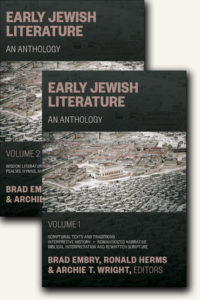
Early Jewish Literature: An Anthology
Brad Embry, Ronald Herms and Archie T. Wright. Early Jewish Literature: An Anthology. Grand Rapids: Eerdmans, 2018. Vol. 1, 728 pp.; Vol. 2, 756 pp. $125.00.
Reviewed by David Wallace
Early Jewish Literature: An Anthology (EJL) provides a fresh introduction to literature from the Second Temple period by presenting an in-volume access to a wide range of primary material used by Jewish groups in the first centuries BCE and CE. Because of the importance of this literature to some of the early Christian communities, highlighted points of contacts related to New Testament texts are discussed in introductory sections.
The two-volume work is arranged by literary genre based on form and theme. A description of the specific characteristics of each genre is given at the beginning of each chapter. Volume 1 includes: (1) Scriptural Texts and Traditions—such as the Book of Daniel, additions to Daniel, the Great Isaiah Scroll, and Psalms at Qumran; (2) Interpretive History—selected books of Maccabees and Josephus; (3) Romanticized Narrative, such as Tobit, Joseph and Aseneth, and Life of Adam and Eve; (4) Biblical Interpretation and Rewritten Scripture—Jubilees and representative Qumran scrolls.
Volume 2 includes: (5) Wisdom Literature and Legal Texts, such as Sirach, Wisdom of Solomon, Rule of the Community, Damascus document, and other Qumran texts; (6) Apocalyptic Literature—First Enoch, Sibylline Oracles (Books 3–5), The War Scroll, Messianic Texts from Qumran, Fourth Ezra, and Second Baruch; (7) Psalms, Hymns, and Prayers, such as Psalms of Solomon, Odes of Solomon, and other select Qumran texts; and (8) Testamentary Literature—Testament of Levi, Testament of Abraham, Testament of Moses, and the Aramaic Levi document.
Each unit begins with a relevant introduction to the documents by the author, followed by a translation of representative texts (most often translated by the author, and, if not, a recent published translation is used). This includes a narrative description of the entire document, relevant background information—author, provenance, date, occasion, sources, and transmission history—general overview of the theology of the book, and bibliography for further reading. Each of the background topics are discussed in approximately a page or less, presented in a readable format with specificity that would keep the interest of graduate and undergraduate students. Each volume also contains a glossary of key terms.
EJL also incorporates relevant yet uncomplicated charts, synoptic comparisons, structural outlines, and useful lists to facilitate in educating the reader. For example, in the Apocalyptic Literature chapter, the content from the Q285 fragment is placed alongside Isaiah 10:33–11:5, demonstrating the shared theme of the “shoot” coming out of Jesse (2:384). In the discussion on 4 Ezra, apocalyptic images of world powers (Babylon/Rome; 2:390) are compared from Daniel 7, 4 Ezra 11–12, and Revelation 13 and 17–18. And a key nomenclature chart for Ezra is given (2:393).
The drawbacks for EJL are few and to be expected from a two-volume anthology. The selection of primary texts requires limitation, and this is true for the length of background descriptions and theological discussions for the respective documents. By choosing some, other texts and information are left out—for example, only Testament of Levi, Testament of Abraham, and Testament of Moses are included in the Testamentary Literature unit (2:597–669); 1 Enoch is presented in the Apocalyptic Literature section, but not 2 or 3 Enoch; and the discussion of the theological significance for the Great Isaiah Scroll is two concise paragraphs (1:109). But this is the nature of a quality didactic anthology meant for scholars and students, and in order to offer a valuable balance of academic expertise, student readability, and opportunity for insights, purposed selections of primary documents from the Second Temple period must be made.
Thus Embry, Herms, and Wright fulfill expectations. First, EJL successfully brings together a wide range of literature from the Second Temple period with the consultation of specialized scholars in the field. Second, relevant primary texts and fragments from the same period that have been typically isolated from each other because of their historical location, provenance, and purposes (e.g., 1 Maccabees and Josephus, 1 Enoch and Sibylline Oracles, Dead Sea Scroll documents and Wisdom literature) are arranged according to shared characteristics, themes, and related contexts. As a result of this process of reading primary sources according to genre, EJL provides an important platform for continued study in early Judaism, as well as the New Testament (and later rabbinic and patristic periods), engendering exploratory interest and valuable insight.
David Wallace, Assistant Professor of New Testament, Regent University, Virginia Beach, VA
